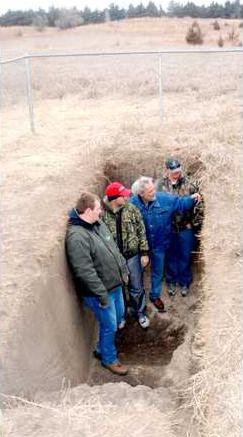To the average person, the gaping, 6-foot-deep soil pit that was dug last fall south of the Barton Community College campus is just a large, rectangular hole in the ground. To Barton agriculture students, it’s a chance to play in the dirt and to earn college credit for doing it. But to Dr. Victor Martin, Barton’s Agriculture instructor, the huge hole represents a portal to wondrous discovery of what took place hundreds of years before with climate, earth and living beings.
"Soil science is only a couple hundred years old, but it’s an important science because we can tell the history of a place by examining its soil," said Martin, who is in his first year as coordinator and instructor of Barton’s Ag program. "This soil pit gives our students the opportunity to study and to get dirty in the soil finding things out through their own discovery."
Martin said the pit will primarily be used for the Introduction to Soils class, but it will be used by most of the other agriculture classes, too, such as Plant Science, Economic Entomology, Crop Protection, Crop Production, and Fertilizer Management. Environmental science classes may also find the pit useful, he added.
Without digging into the walls of the site, Martin can already provide a fairly remarkable glimpse into yesteryear. As he talked to a small group gathered for the soil pit dedication on a cold, blustery morning last November, he pointed to a layer of darker soil about a foot down from the top.
"That soil probably got buried by flood four or five-hundred years ago," he explained to the group. "There was a major flooding event and a bunch of silt and topsoil came in and settled over the top of it, which makes sense because we are in a bottom — in a flood plain."
He pointed deeper down into the pit at a white, chalky layer of soil and noted that it was most likely formed by calcium carbonate. Then he finished his soil assessment with an overall observation.
"We found roots nearly five feet down, which tells you this is a good prairie soil."
The soil pit was funded with a mini-grant, provided by the College’s Foundation last fall. Martin worked with the College’s Physical Plant to detail the project; Physical Plant staff excavated the pit and enclosed it with a 4-foot-tall, chain-linked, safety fence and a gate. During the soil pit dedication, Martin said he was especially thankful to grounds supervisor Rocky Meitner for doing the excavation and erecting the fence. He also thanked Darnell Holopirek, executive director of Institutional Advancement, for providing the grant, in addition to all those who supported the project.
"Thanks to the support of everyone involved, we’re going to have fun getting to see and touch the history of soils in this area," said Martin.





